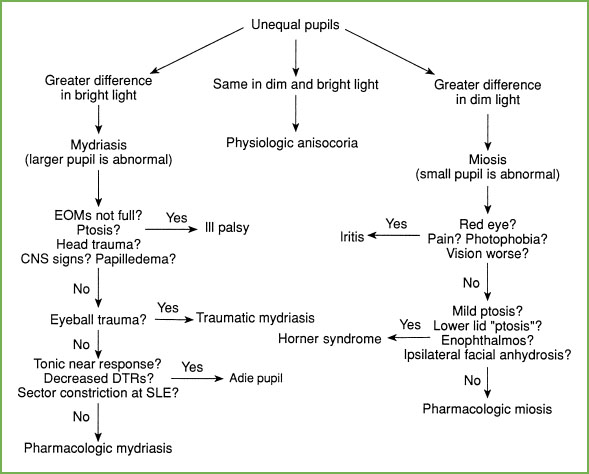
A total of 172 patients were originally enrolled. These patients typically require ICP monitoring and often exhibit a high potential for early changes in brain volume. The patients had the following diagnoses: subdural hematoma (SDH), subarachnoid hemorrhage (SAH), epidural hematoma (EDH) induced from TBI, aneurysmal SAH, or spontaneous intracerebral hemorrhage (ICH). The study was approved by the institutional review boards at each of the eight sites, and informed consent was obtained from the family members prior to enrolment in the study. Patients were enrolled from a total of eight different neurological/critical care ICU sites. This paper introduces the concept of Neurological Pupil index (NPi) as a means to assess pupillary response and investigate trends in the ICP of severely brain-injured patients. A more sensitive means to track and classify pupillary changes would be of particular utility in the early evaluation of patients with suspected intracranial pathology and elevated ICPs, before imaging studies are completed and ICP monitors are placed. High ICPs are associated with pupillary abnormalities of brain-injured patients. ICP monitoring is invaluable in directing therapy for the brain-injured patient. Historically, it has been shown that high ICPs (>20 mmHg) in brain-injured patients result more frequently in poor neurological outcomes and death. Intracranial pressure (ICP) has been monitored dating back to over 100 years ago. In a recent study, there was a 39% discrepancy in agreement amongst examiners. These factors may include, for example, poor lighting conditions in the patient's room, the examiner's visual acuity, and the strength of the flashlight stimulus, as well as its distance and orientation with respect to the patient's eye. Moreover, ambient light conditions can affect the validity of the visual assessment of the pupil and increase the inter-observer disagreement.
CAUSE OF UNEQUAL PUPIL SIZE MANUAL
A more precise assessment of the pupil is problematic, since manual pupillary assessment as part of the clinical routine is subject to compounded sources of inaccuracies and inconsistencies, and is characterized by large inter-examiner variability. These subjective terms are often applied without a standard clinical protocol or definition. Patients who undergo prompt intervention (i.e., surgery, hyperventilation, hyperosmolar therapy) after a new pupillary abnormality have improved recovery potential.Ĭommon terminology employed in the clinical literature to describe the pupillary light reflex and pupil size includes “unilateral” or “bilateral nonreactive pupils”, “fixed” or “dilated pupils”, as well as “brisk”, “sluggish”, and “nonreactive” pupils. It has been shown that neurosurgeons have the tendency to triage patients into either conservative therapy or surgical evacuation of mass lesions, depending on the status of the pupils.


In addition to herniation and third nerve compression, it has been shown through blood flow imaging that pupillary changes in the neurological intensive care unit (ICU) are highly correlated with brainstem oxygenation and perfusion/ischemia.įurthermore, other investigators have used pupil size and reactivity as the fundamental parameters of more general outcome predictive models in conjunction with other clinical information such as age, mechanism of injury and Glasgow Coma Scale (GCS), and have correlated such models with the presence and the location of intracranial mass lesions. Depressed light reflex and anisocoria have been associated with such phenomena, and they have been proposed as prognostic indicators of functional recovery after traumatic transtentorial herniation. More specifically, the location of the pupillomotor nuclei in the dorsal midbrain and the efferent oculomotor nerve running from the midbrain to the superior orbital fissure is particularly important for assessing the onset of descending transtentorial herniation and brainstem compression. In the management and prognosis of severe traumatic brain injury (TBI), abnormalities of pupillary response or anisocoria (pupil size asymmetries) are often associated with neurological deteriorations, and they are correlated with poor neurological outcome. This makes the pupil size and the pupillary light reflex an important factor to be considered in many clinical conditions as described, for example, in the work of Loewenfeld. Different neuroanatomical pathways are involved in the control of the pupil, and the integrity and functionality of these neurological pathways can often be ascertained through the analysis and interpretation of pupillary behavior.


 0 kommentar(er)
0 kommentar(er)
